GALEX Feature Stories
-

Feature: Flares May Threaten Planet Habitability Near Red Dwarfs
Data from the GALEX spacecraft suggest that planets around cool dwarf stars may be subjected to intense flares.
-

Feature: 'Frankenstein' Galaxy Surprises Astronomers
The galaxy UGC 1382 has been revealed to be far larger and stranger than previously thought. Astronomers relied on a combination of ground-based and space telescopes to uncover the true nature of this "Frankenstein galaxy."
-

Feature: Funky Light Signal From Colliding Black Holes Explained
Entangled by gravity and destined to merge, two candidate black holes in a distant galaxy appear to be locked in an intricate dance. Researchers using data from NASA's Galaxy Evolution Explorer (GALEX) and NASA's Hubble Space Telescope have come up with the most compelling confirmation yet for the existence of these merging black holes and have found new details about their odd, cyclical light signal.
-
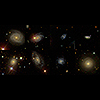
Feature: Astronomers Upgrade Their Cosmic Light Bulbs
A new report identifies top-of-the-line tools for studying the fabric of space.
-

Feature: Slow-Growing Galaxies Offer Window to Early Universe
What makes one rose bush blossom with flowers, while another remains barren? Astronomers ask a similar question of galaxies.
-

Feature: Gravity-Bending Find Leads to Kepler Meeting Einstein
The light of a red star is warped and magnified by its dead-star companion, as detected by NASA's Kepler space telescope.
-

Feature Story: The Helix Nebula: Bigger in Death than Life
What was once a fairly average star, not much different than our sun, can be seen unraveling at the seams in this new image from the Spitzer and GALEX space telescopes.
-

From NASA's ASK Magazine: GALEX: Managing the Unexpected
Explorers are among the lowest-cost missions flown by NASA, but they can pack a big scientific punch. Such is the case with the Galaxy Evolution Explorer, or GALEX, a mission designed to map the history of star formation over 80 percent of the age of the universe.
-
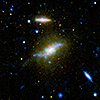
Feature Story: Cosmic 'Leaf Blower' Robs Galaxy of Star-Making Fuel
Supernova explosions and the jets of a monstrous black hole are scattering a galaxy's star-making gas like a cosmic leaf blower.
-

Feature Story: NASA's Galaxy Evolution Explorer in Standby Mode
NASA's Galaxy Evolution Explorer was placed in standby mode today as engineers prepare to end mission operations, nearly nine years after the telescope's launch.
-
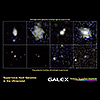
Feature Story: Ultraviolet Spotlight on Plump Stars in Tiny Galaxies
Astronomers using NASA's Galaxy Evolution Explorer may be closer to knowing why some of the most massive stellar explosions ever observed occur in the tiniest of galaxies.
-
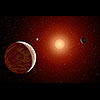
Feature Story: NASA Telescope Ferrets Out Planet-Hunting Targets
Astronomers have come up with a new way of identifying close, faint stars with NASA's Galaxy Evolution Explorer satellite. The technique should help in the hunt for planets that lie beyond our solar system, because nearby, hard-to-see stars could very well be home to the easiest-to-see alien planets.
-
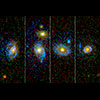
Feature Story: Giant Ultraviolet Rings Found in Resurrected Galaxies
Astronomers have found mysterious, giant loops of ultraviolet light in aged, massive galaxies, which seem to have a second lease on life.
-
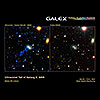
Feature Story: Astronomers Discover Star-Studded Galaxy Tail
NASA's Galaxy Evolution Explorer has discovered a galaxy tail studded with bright knots of new stars. The tail, which was created as the galaxy IC 3418 plunged into the neighboring Virgo cluster of galaxies, offers new insight into how stars form.
-
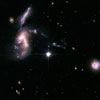
Feature Story: Jurassic Space: Telescopes Probe Ancient Galaxies Near Us
Imagine finding a living dinosaur in your backyard. Astronomers have found the astronomical equivalent of prehistoric life in our intergalactic backyard.
-
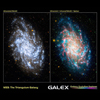
Feature Story: NASA's Galaxy-Exploring Mission Celebrates Sixth Anniversary
NASA's Galaxy Evolution Explorer Mission marks its sixth anniversary studying galaxies beyond our Milky Way through its sensitive ultraviolet telescope, the only such far-ultraviolet detector in space.
-
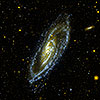
Feature Story: Galaxy Evolution Explorer Celebrates Five Years in Space
Since its launch five years ago, the Galaxy Evolution Explorer (GALEX) has photographed hundreds of millions of galaxies in ultraviolet light. M106 is one of those galaxies, and from 22 million light years away, it strikes a pose in blue and gold for this new commemorative portrait.
-
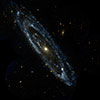
Feature Story: Revisiting Classic Stellar "Real Estate" with GALEX
As the most sensitive ultraviolet telescope ever launched, NASA's Galaxy Evolution Explorer (GALEX) scouts galaxies, or "stellar communities," over 10 billion years of cosmic history.
-

Feature Story: Watching Galaxies Grow Old Gracefully
In the early 1900s, Edwin Hubble made the startling discovery that our Milky Way galaxy is not alone. It is just one of many galaxies, or "island universes," as Hubble dubbed them, swimming in the sea of space.
-
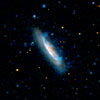
Feature Story: Galactic Nature Vs. Nurture
Just as psychologists have pondered the age-old question of "nature vs. nurture" in humans, astronomers are tackling a similar cosmic dilemma -- how much of a galaxy's development is due to innate characteristics, and how much is affected by the surrounding environment?
-
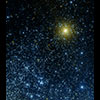
Feature Story: Band of Stars
The Galaxy Evolution Explorer's ultraviolet eyes have captured a globular star cluster, called NGC 362, in our own Milky Way galaxy. In this new image, the cluster appears next to stars from a more distant neighboring galaxy, known as the Small Magellanic Cloud.
-
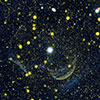
Feature Story: GALEX Searches for Milky Way's Missing White Dwarfs
Astronomers have long suspected that the glowing embers of dying stars, once more massive than our Sun, may hold valuable clues about the origins and inner workings of our Milky Way galaxy. The only problem is finding them.
-
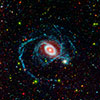
Feature Story: GALEX Gauges a Galaxy's Growing Pains
When Dr. David Thilker of Johns Hopkins University, Baltimore, Md., looked at an image of nearby spiral galaxy NGC 2841 taken by the panoramic ultraviolet eyes of NASA's Galaxy Evolution Explorer (GALEX), it first seemed the scale of the image was incorrect. Then, he realized something far more interesting was happening.
-

Feature Story: GALEX Studies a Stellar Bully in Our Milky Way Galaxy
Unlike our Sun, a relative "cosmic loner," many of the Milky Way galaxy's stars actually lurk in groups of two or more. In most of these systems, the inhabiting stars have no problem co-existing peacefully with their stellar companions. However, astronomers have found a few exceptions.
-

Feature Story: NASA's Galaxy Evolution Explorer Looks Beyond a Comet's Dusty Tail
Comets may be admired for their spectacular "tails," but in their "hearts" they carry important ingredients that could shed light on conditions in the early solar system and planet formation.
-
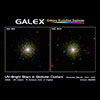
Feature Story: Galaxy Evolution Explorer Hunts for Stellar Misfits
Scientists are hoping the powerful ultraviolet eyes of NASA's Galaxy Evolution Explorer (GALEX) will help shed some light on a species of stellar misfits called "blue stragglers," which are old, hot objects that have puzzled astronomers since their discovery 50 years ago.
-

Feature Story: Spotlight on GALEX Guest Investigator Projects
Don't let size fool you. Weighing in at 500 pounds, the Galaxy Evolution Explorer (GALEX) may be classified as one of NASA's Small Explorers, but it has enormous scientific capabilities.




